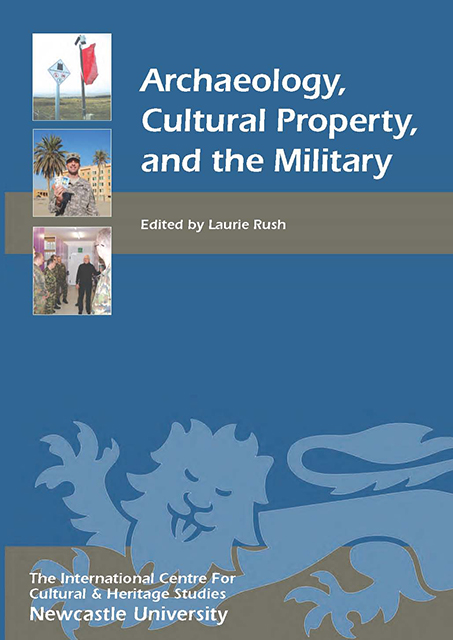Book contents
- Frontmatter
- Contents
- List of Illustrations: Figures and Tables
- Archaeology and the Military: An Introduction
- 1 The Obligations Contained in International Treaties of Armed Forces to Protect Cultural Heritage in Times of Armed Conflict
- 2 Rescuing Europe’s Cultural Heritage: The Role of the Allied Monuments Officers in World War II
- 3 The UK’s Training and Awareness Programme
- 4 US Army Civil Affairs: Protecting Cultural Property, Past and Future
- 5 Cultural Property Protection in the Event of Armed Conflict: Deploying Military Experts or Can White Men Sing the Blues?
- 6 Good Training and Good Practice: Protection of the Cultural Heritage on the UK Defence Training Estate
- 7 In-Theatre Soldier Training through Cultural Heritage Playing Cards: A US Department of Defense Example
- 8 Dealing the Heritage Hand: Establishing a United States Department of Defense Cultural Property Protection Program for Global Operations
- 9 Teaching Cultural Property Protection in the Middle East: The Central Command Historical/Cultural Advisory Group and International Efforts
- 10 Cultural Resources Data for Heritage Protection in Contingency Operations
- 11 Time not on my Side: Cultural Resource Management in Kirkuk, Iraq
- 12 US Military Support of Cultural Heritage Awareness and Preservation in Post-Conflict Iraq
- 13 Operation Heritage
- 14 Cultural Property Protection in the Event of Armed Conflict – Austrian Experiences
- 15 The Role of the Swiss Armed Forces in the Protection of Cultural Property
- 16 Preserving Global Heritage from Space in Times of War
- Appendix 1 1954 Hague Convention and its two Protocols
- Appendix 2 Author Biographies
- Index
14 - Cultural Property Protection in the Event of Armed Conflict – Austrian Experiences
Published online by Cambridge University Press: 28 February 2023
- Frontmatter
- Contents
- List of Illustrations: Figures and Tables
- Archaeology and the Military: An Introduction
- 1 The Obligations Contained in International Treaties of Armed Forces to Protect Cultural Heritage in Times of Armed Conflict
- 2 Rescuing Europe’s Cultural Heritage: The Role of the Allied Monuments Officers in World War II
- 3 The UK’s Training and Awareness Programme
- 4 US Army Civil Affairs: Protecting Cultural Property, Past and Future
- 5 Cultural Property Protection in the Event of Armed Conflict: Deploying Military Experts or Can White Men Sing the Blues?
- 6 Good Training and Good Practice: Protection of the Cultural Heritage on the UK Defence Training Estate
- 7 In-Theatre Soldier Training through Cultural Heritage Playing Cards: A US Department of Defense Example
- 8 Dealing the Heritage Hand: Establishing a United States Department of Defense Cultural Property Protection Program for Global Operations
- 9 Teaching Cultural Property Protection in the Middle East: The Central Command Historical/Cultural Advisory Group and International Efforts
- 10 Cultural Resources Data for Heritage Protection in Contingency Operations
- 11 Time not on my Side: Cultural Resource Management in Kirkuk, Iraq
- 12 US Military Support of Cultural Heritage Awareness and Preservation in Post-Conflict Iraq
- 13 Operation Heritage
- 14 Cultural Property Protection in the Event of Armed Conflict – Austrian Experiences
- 15 The Role of the Swiss Armed Forces in the Protection of Cultural Property
- 16 Preserving Global Heritage from Space in Times of War
- Appendix 1 1954 Hague Convention and its two Protocols
- Appendix 2 Author Biographies
- Index
Summary
THE ORIGIN OF MILITARY CPP IN AUSTRIA
The current Austrian situation concerning the standard and level of implementation of the 1954 Hague Convention for the Protection of Cultural Property in the Event of Armed Conflict, especially within the Austrian Armed Forces (AAF), is not the product of concentrated and well-organised activity; it is rather the result of a number of individuals’ efforts while working in a variety of positions at the right time. A long time passed between Austria's 1964 ratification of the 1954 Hague Convention and its implementation and dissemination within the AAF.
The first Austrian ‘military mission’ in which cultural property protection (CPP) played a minor, although unofficial role, occurred in 1968 in the context of the ‘Prague Spring’. The Austrian government and military leaders expected Soviet troops to cross Austrian territory on their way to Prague, violating the country's sovereignty and neutrality. Knowing that the Soviet troops could not be stopped by military force, Austria prepared for invasion. On the initiative of the Federal Bureau for Monuments and Sites (FBMS), and under the supervision of its provincial departments, hundreds of copies of the Blue Shield, the emblem of the 1954 Hague Convention, were distributed in several districts of eastern and northern Austria and, through the active participation of gendarmerie and army officers, these were attached to historical or cultural monuments along the predicted Soviet route through Austria. It was greatly feared that Soviet troops would not respect the country's rich cultural heritage, which had already suffered so badly during World War II – at this time the traces of this damage and destruction were still visible at many cultural sites. The idea was that this time the enemy would at least be made aware of the fact that with every single destructive step they took they were likely to be violating international law. This form of resistance without force at the climax of the Cold War signalled the birth of a kind of ‘Blue Shield Movement’ in Austria which finally resulted in the foundation of the Austrian Society for the Protection of Cultural Property in 1980. This civil organisation is still characterised by many regular and militia army officers among its membership, who are entrusted with most of the positions on its steering board.
- Type
- Chapter
- Information
- Archaeology, Cultural Property, and the Military , pp. 145 - 158Publisher: Boydell & BrewerPrint publication year: 2010
- 3
- Cited by



